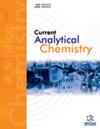In vitro Antioxidant Activity of 5-caffeoylquinic Acid and Ester Analogues
IF 1.7
4区 化学
Q3 CHEMISTRY, ANALYTICAL
引用次数: 0
Abstract
Background: Chlorogenic acid, an ester of caffeic acid with quinic acid, also known as 5- O-caffeoylquinic acid (5-CQA), is a ubiquitous plant constituent that is an important intermediate in lignin biosynthesis. In some cases, it occurs at surprisingly high levels in the leaves and fruits of certain higher plants, such as coffee beans. Due to its catechol moiety and an extended side chain conjugation, it easily forms a resonance-stabilised phenoxy radical, accounting for its powerful antioxidant potential. Objective: The objective of this work was to determine if the esterification and methylation of 5- CQA would enhance its antioxidant activity. Methods: Two 5-CQA derivatives were prepared for this study. Chlorogenic acid was esterified with methanol over Amberlite IR120-H to obtain methyl chlorogenate, while methyl 3',4´-dimethyl chlorogenate was prepared from 5-CQA by treatment with diazomethane. Spectroscopic methods confirmed the structure of these derivatives. Their antioxidant properties were tested to establish a relationship between structure and antioxidant activity. Results: Antioxidant activity results were generated for 5-CQA and its ester analogues using eight different methods. Depending on the method applied, results were expressed as IC50/MCE50 values or as equivalents of the applied standard (ascorbic acid and Trolox). Conclusion: In most of these tests, 5-CQA showed the highest antioxidant activity compared to its derivatives. Nevertheless, due to their hydrophobic characteristics, their ester analogues remain promising antioxidant candidates in emulsifying systems.5 咖啡酰奎宁酸及其酯类化合物的体外抗氧化活性
背景:绿原酸是咖啡酸与奎宁酸的酯类,又称 5- O-咖啡酰奎宁酸(5-CQA),是一种无处不在的植物成分,是木质素生物合成过程中的重要中间体。在某些情况下,它在某些高等植物(如咖啡豆)的叶子和果实中的含量出奇地高。由于其儿茶酚分子和延长的侧链共轭,它很容易形成共振稳定的苯氧自由基,因此具有强大的抗氧化潜力。研究目的这项工作的目的是确定 5- CQA 的酯化和甲基化是否会增强其抗氧化活性。方法:制备了两种 5-CQA 衍生物:本研究制备了两种 5-CQA 衍生物。绿原酸与甲醇在 Amberlite IR120-H 上进行酯化反应,得到绿原酸甲酯,而 3',4´-二甲基绿原酸甲酯则是用重氮甲烷处理 5-CQA 制备的。光谱方法证实了这些衍生物的结构。测试了它们的抗氧化性,以确定结构与抗氧化活性之间的关系。结果:采用八种不同的方法得出了 5-CQA 及其酯类类似物的抗氧化活性结果。根据所用方法的不同,结果以 IC50/MCE50 值或所用标准(抗坏血酸和三氯氧磷)的当量表示。结论在大多数测试中,5-CQA 的抗氧化活性都高于其衍生物。不过,由于其疏水特性,它们的酯类类似物仍然是乳化体系中很有希望的抗氧化剂。
本文章由计算机程序翻译,如有差异,请以英文原文为准。
求助全文
约1分钟内获得全文
求助全文
来源期刊

Current Analytical Chemistry
化学-分析化学
CiteScore
4.10
自引率
0.00%
发文量
90
审稿时长
9 months
期刊介绍:
Current Analytical Chemistry publishes full-length/mini reviews and original research articles on the most recent advances in analytical chemistry. All aspects of the field are represented, including analytical methodology, techniques, and instrumentation in both fundamental and applied research topics of interest to the broad readership of the journal. Current Analytical Chemistry strives to serve as an authoritative source of information in analytical chemistry and in related applications such as biochemical analysis, pharmaceutical research, quantitative biological imaging, novel sensors, and nanotechnology.
 求助内容:
求助内容: 应助结果提醒方式:
应助结果提醒方式:


